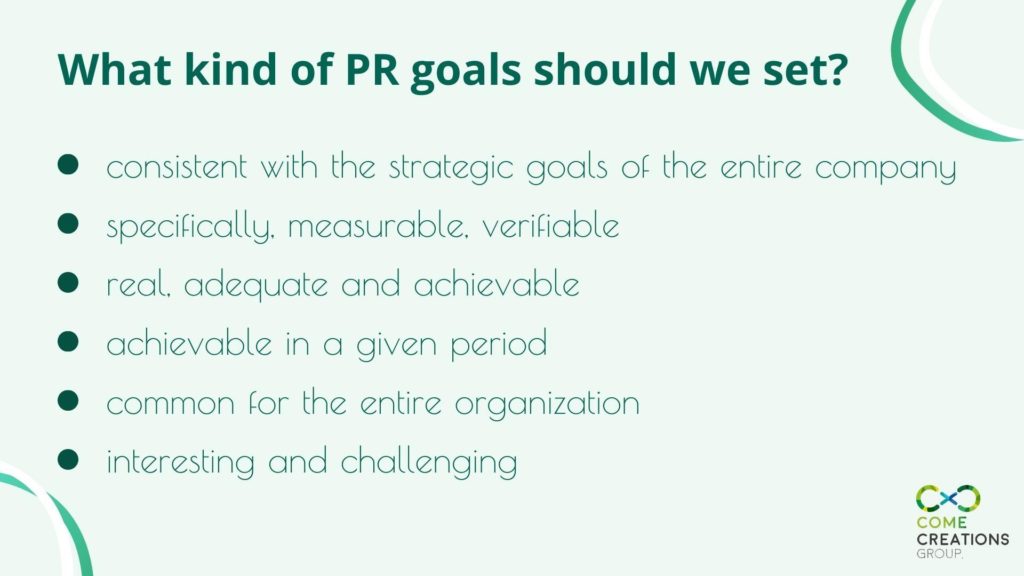There are many types of public relations (PR) activities—they can focus on media relations, marketing, social communication, management, and consulting. However, all public relations have one main goal: image creation, the making of a positive and coherent image in the eyes of recipients. They also support other areas in the organization, e.g., sales.
Before starting to set PR goals, think about what you want to achieve. Depending on the brand for which you are implementing the strategy, it is worth considering what the client’s needs are and what effects are realistic to achieve. Making empty promises may result in mutual accusations, and this is what we want to avoid. That is why correctly setting PR goals is so important.
What Should Be the PR goals?
- PR goals should arise from the needs of the organization and should be supporting, strategic goals for the entire company. For example, there could be goals relating to acquiring new customers. It may turn out that writing another blog post will not bring any benefits, because few people visit your website, whereas publishing an article on an industry portal will allow you to reach people who have never had contact with your company before.
- Goals should be concrete, measurable, and verifiable, e.g., “get 10 media publications per month” instead of “increase the number of media publications,” or, “get 100 new subscriptions to the newsletter monthly” instead of “develop a community-focused company”.
- Make them real, adequate, and achievable—goals that you are able to cope with.
- They should be realizable in a given period.
- The entire organization should have something in common with the PR goals so that all members can identify with them.
- It should be interesting and challenging for those who pursue their goals.

In order to properly assess the effectiveness of PR goals, it is also necessary to consider whether the implementation of your goals will allow you to reach people and respond to their needs. People such as customers and business partners are representatives of the company’s environment and are those whose attention we care most about.
Indicators That Can Be Used to Measure the Effectiveness of PR Goals
Your communication strategy may contain various types of indicators by which you will measure the success of your assumptions. One of them should be, among others, Advertising Value Equivalency, which expresses the price that would be payable for publishing or broadcasting a given material if it were a paid advertisement.
A second way to measure the success of PR goals is the range of publications, by which you can determine the number of people your message reached.
Among the other important indicators, there are also Key Performance Indicators (KPI). These are nothing more than a key determinants of the effectiveness of activities. These activities include, for example, increasing the number of blog posts per month. However, this will not necessarily translate into the company’s strategic goals.
The last set of indicators, Key Success Indicators (KSI), can be used to account for these activities. In this case, you have to use specific increases — more publications and more followers on social media.
Examples of PR Goals That May Appear in the Company’s Strategy:
- Acquiring X valuable publications in a month.
- Acquiring X subscriptions to the newsletter monthly.
- Gaining X new followers on social media in a given period of time.
- Establishing a good relationship with X journalists in a given period of time.
- Launching advertisements on social media that will reach X people in a given period of time.
- Organizing X conferences and press breakfasts in a given period of time.
- Organizing X webinars over a period of time.
- Auditing the website and implementing corrections.

How Often to Check the Implementation of PR Goals and Set New Ones?
When implementing PR goals, it is worth setting a certain period of time in which you want to achieve the given effects. Short periods work best. In our opinion, it is worth developing strategies every quarter and measuring effectiveness every month. By doing this, we are able to determine whether the chosen direction still meets the requirements of the organization and whether our assumptions turned out to be too high. If there are obstacles or setbacks along the way, it is also worth investigating what influenced them.
Summary
Many companies operate without a developed communication strategy, probably due to the lack of set goals. However, it is difficult to manage processes and teams if you are not able to verify the results. In our opinion, the key to success is planning activities in advance and have a good understanding of the client’s needs.
If you want us to help you organize a communication strategy based on achievable goals, please contact us!